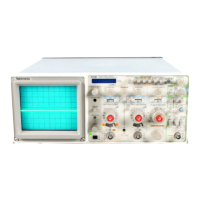
Do you have a question about the Tektronix 2236 and is the answer not in the manual?
| Type | Oscilloscope |
|---|---|
| Bandwidth | 100 MHz |
| Channels | 2 |
| Vertical Sensitivity | 2 mV/div to 5 V/div |
| Memory Depth | 1 kpts |
| Counter Resolution | 8 digits |
| Rise Time | 3.5 ns |
| Max Input Voltage | 400 V (DC + AC peak) |
| Display | CRT |
| Counter Frequency Range | 10 Hz to 100 MHz |
| Input Impedance | 1 MΩ |
| Power Supply | 48-440 Hz |
| Trigger Modes | Auto, Normal, Single |
Defines terms and symbols used in the manual and on the equipment.
Details safe power source usage, grounding, and hazards of losing ground connection.
Covers safe use of fuses, power cords, and operating environment considerations.
Provides an overview of the 2236 oscilloscope's features and capabilities.
Lists electrical characteristics, environmental factors, and physical dimensions of the 2236.
Outlines when to check instrument performance for calibration.
Provides instructions for safely packaging the instrument for service or repair.
Covers initial setup including safety, power, and fuses for first-time operation.
Details line voltage range, power cord connection, and fuse safety.
Emphasizes maintaining adequate cooling by keeping ventilation holes clear.
Describes controls related to display, power status, and probe adjustment output.
Covers graticule, grounding, signal connections, and precharging for accurate measurements.
Explains the graticule markings for accurate measurements without parallax error.
Stresses the importance of proper grounding for accurate signal measurements.
Discusses using probes and coaxial cables for connecting signals to the instrument.
Explains the procedure for charging the input coupling capacitor to prevent transients.
Guides on verifying operation and performing adjustments before making measurements.
Provides steps to establish a baseline trace by presetting controls and warming up the instrument.
Details how to align the CRT trace parallel to the center horizontal graticule line.
Step-by-step guide for compensating probes using the PROBE ADJUST output.
Outlines compensation for AC RMSV measurements using a calibration system.
Introduces procedures for making basic measurements with the 2236 oscilloscope.
Procedure for measuring peak-to-peak voltage of a waveform.
How to measure the voltage level at a specific point on a waveform.
Displays the sum or difference of two input signals.
Method to eliminate unwanted frequency components from signals.
Compares unknown signals to a known reference signal for amplitude.
Steps to display a TV Line signal using trigger modes and sweep settings.
Steps to display a TV Field signal using trigger modes and sweep settings.
Explains operating B Sweep in nontriggered mode for apparent magnification.
Procedure to measure time variations in repetitive pulses.
Uses triggered B Sweep for stable magnification of waveform sections.
Measures the time interval between repetitive pulses.
Measures the frequency of repetitive signals.
Measures the time interval of a signal pulse.
Uses Delta Time function for general timing measurements on single waveforms.
Measures the time for a signal to transition from low to high.
Measures time difference between pulses using triggered delay time.
Compares timing between signals on different channels.
Measures the phase shift between two signals of equal frequency.
Performs frequency, period, width, and totalize measurements using a B Trigger gate interval.
Measures resistance and forward voltage drop of semiconductors.
Checks for continuity in circuits by measuring resistance.
Measures the true RMS value of AC input signals.
Measures DC voltage levels.
Measures DC and AC RMS voltage using Channel 1 input.
Measures temperature using the P6602 temperature probe.
Provides an overview of available instrument options and accessories.
Replaces internal clock with a crystal oscillator for improved accuracy.
Provides impact protection for industrial and service environments.
Lists Tektronix part numbers for various international power cords.
Lists accessories provided with each instrument.
Lists optional accessories recommended for use with the instrument.
Notifies a change in the part number for the Standard Power Cord.
